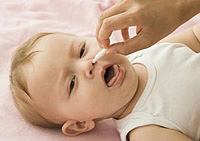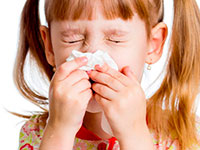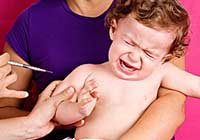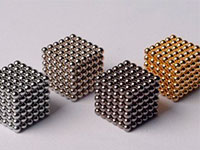What is diphtheria? How diphtheria is manifested? How treatment and prophylaxis of diphtheria? Answers to these questions you will find in the article.
Content
What is diphtheria
Diphtheria - infectious disease caused by diphtheria bacteria transmitted by air-droplet, characterized by inflammation of predominantly mucous membranes of rotational and nasopharynges, as well as phenomena of general intoxication and damage in internal organs.
Factor of pathogens - emitted toxin.
Source of infection - patient or carrier of diphtheria stick. Transmission paths - air-drip, contact, less often food. People of almost all ages, not having immunity to the causative agent and its toxin.
Difteria causative agent is resistant to external environment. In the diphtheritic film, it remains for 3-5 months, in dust - up to 2 months, on food products - up to 12-18 days, in the droplets of saliva, remaining on the walls of the glass, on the handles of the doors, on children's toys, diphtheria bacteria can be saved 15 Days. Corimbacterium survival on environmental objects in the autumn-spring period can reach 5.5 months, and all this time the pathogen's pathogen properties are preserved.
The duration of the incubation period is 2-7 days (perhaps up to 12 days).
How diphtheria is manifested
 The rotogling difftheria begins acutely from choking or cognition, increasing body temperature, more often than 38s, although the 2nd day of the disease can be a higher temperature. At the same time, other signs of intoxication appear (negative impact on the body of toxicants): headache, pronounced weakness, can be a faint condition. From the first hours of the disease, a moderate sore throat appears when swallowing, which increases during the day. Submandibular lymph nodes are slightly painful, sometimes moderately increased. Fever period lasts no more than 3 days. With normalization of temperature, all the phenomena of intoxication almost disappear, decreases or disappears pain in the throat when swallowing. The mucous membrane of the rotogling with a localized form of diphtheria is moderately blissful, as a rule, the blust area has the form of a narrow rim, which focuses film. Mucous membrane almonds Even, relief smoothed. The film is located preferably on the convex surface of the almonds, dense, grayish-white or dirty gray with a smooth shiny surface, well-limited edges, the same thickness all over, is difficult to remove the spatula. With an islands, the film has a view of the sitting islands with the wrong outlines; With the film, the film covers a significant part of the almonds, and with a tonsillar, it envelops the entire almond. Film on almonds without treatment is preserved 6-7 days.
The rotogling difftheria begins acutely from choking or cognition, increasing body temperature, more often than 38s, although the 2nd day of the disease can be a higher temperature. At the same time, other signs of intoxication appear (negative impact on the body of toxicants): headache, pronounced weakness, can be a faint condition. From the first hours of the disease, a moderate sore throat appears when swallowing, which increases during the day. Submandibular lymph nodes are slightly painful, sometimes moderately increased. Fever period lasts no more than 3 days. With normalization of temperature, all the phenomena of intoxication almost disappear, decreases or disappears pain in the throat when swallowing. The mucous membrane of the rotogling with a localized form of diphtheria is moderately blissful, as a rule, the blust area has the form of a narrow rim, which focuses film. Mucous membrane almonds Even, relief smoothed. The film is located preferably on the convex surface of the almonds, dense, grayish-white or dirty gray with a smooth shiny surface, well-limited edges, the same thickness all over, is difficult to remove the spatula. With an islands, the film has a view of the sitting islands with the wrong outlines; With the film, the film covers a significant part of the almonds, and with a tonsillar, it envelops the entire almond. Film on almonds without treatment is preserved 6-7 days.
With the diphtheria of the respiratory tract: a rough cough; voting weight; dyspnea.
In the nose diphtheria: the difficulty of nasal breathing, serous-bloody separated from the nasal moves.
How does diphtheria treatment
- Anti-dialect serum is introduced as early as possible, without waiting for laboratory confirmation of the diagnosis, in / m or in / in the dosage corresponding to the clinical form of the disease. Before introducing a complete dose, a skin or conjunctival trial is carried out on hypersensitivity. Internal sample: diphtheria antitoxine in dilution 1: 100 is introduced intraderially, the reaction is considered positive when the infiltration is for 20 minutes after injection. Conjunctive Sample: Anti-Difteric serum in dilution 1:10 Install the conjunctivation of one eye into the cavity of the conjunctivation of one eye, 0.1 ml of 0.9% sodium chloride solution. The reaction is considered positive when the local reaction appears (itching, redness).
- In all cases (in T.C. And for the carrier) prescribe antibiotics, for example erythromycin of 40-50 mg / kg / day (maximum 2 g / day) for 14 days or benzylpenicillin at 100,000-150,000 units / kg / day in 4 administration in / m.
How does diphtheria prevention
The prophylaxis of diphtheria is carried out by diphtheria anatoxin, which is part of the combined drugs - DC, ADS, ADS-M. The vaccination of children of the first 4 years is carried out three times the drug ADC, 4-6-year-olds are used for this, ads with twofold administration, patients over 6 years old are usually vaccinated by ADS-M. Revaccination is carried out 9-12 months after the completed vaccination course. Repeated administration of ADS-M are performed in 6, 11, 16 years and then every 10 years. In the event of a disease in the children's team of children who were in contact with the patient, they examine bacteriologically and divide on 7 days. Recovery discharge is carried out after a double negative result of bacteriological examination.









